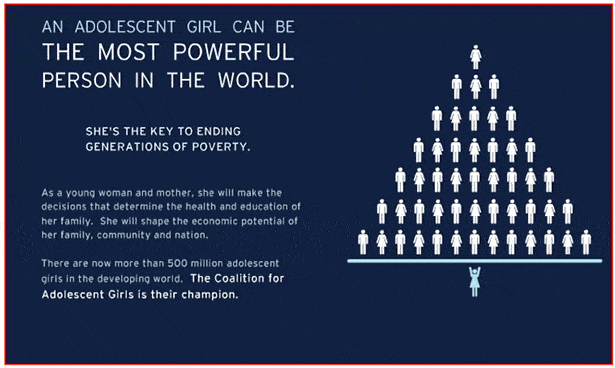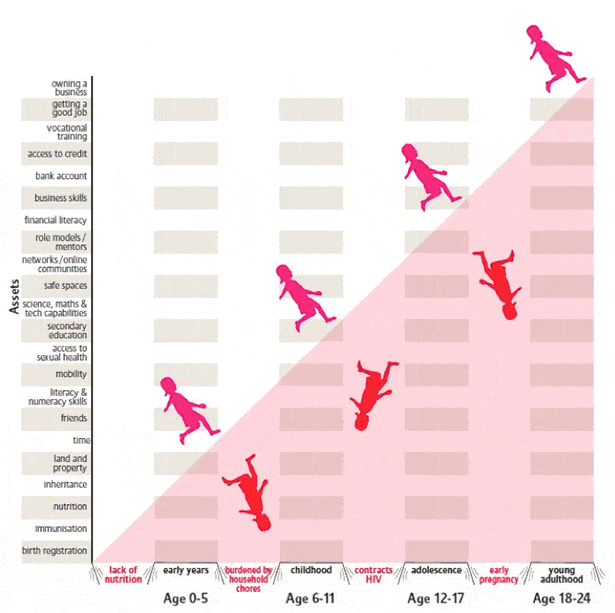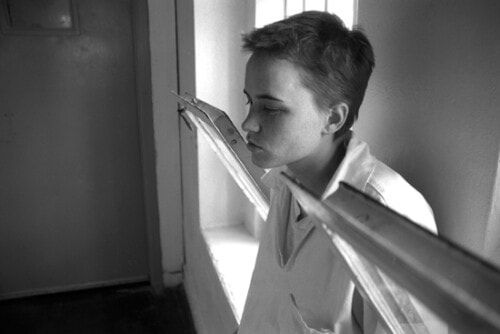Both feminisms and finance are oriented through speculative futures, ranging from a palpable dread of disaster to an excited premonition of a better life. Western feminist promissories and financial gambles merge in the current popularity of “The Girl” as a figure of transnational rescue and investment. In 1992, Lawrence Summers (then chief economist for the World Bank) delivered a famous keynote lecture, “Investing in ALL the People,” at the eighth annual general meeting of the Pakistan Society of Development Economists in Islamabad, in which he argued for the economic benefits of educating girls. Drawing on a thick archive of data produced by social science research on family planning, he offered the calculation that each year of schooling pulls down fertility rates by 5 to 10 percent, such that $30,000 spent on educating 1,000 girls would prevent 500 births. In contrast, a typical family planning program that spent $65 to “prevent” one birth would accomplish the same overall reduction of 500 births for the larger amount of $33,000. Thus, education was $3000 cheaper than contraception. By calculating The Girl as a site of investment, preventing future births was temporally pushed backward in the human life cycle to the pre-childbearing years of life.
In addition, educating girls was correlated with lower mortality and higher future income. Thus for Summers, “educating girls quite possibly yields a higher rate of return than any other investment available in the developing world.” 1 Since fertility reduction is mathematically tied to higher GDP per capita (divide GDP by population) and higher future wages, educating girls provided multiple economic returns.

Summers’ argument of investment and returns rests on the notion of “human capital,” a Nobel-Prize-winning concept crafted in its neoliberal form in the 1960s by Theodore Schultz, and most notably by Chicago school economist Gary Becker. While Milton Friedman is typically credited with Chicago’s most important exports of neoliberal economics, work on human capital is another world-shaping product. Human capital is typically defined as the knowledge, skills, values, personality, and health embodied in people that make them economically productive. In contrast, in economics, “capital” names resources that are used in producing goods or services, but are not themselves commodities for sale (for example, a machine in a factory). Hence, the term “human capital” designates the embodied capacities of a person that can produce future economic benefits for that person, her employer, and even her national economy. Thus, embodiment becomes a kind of future-oriented value.
In Gary Becker’s “new home economics,” choices about fertility were fundamentally rational economic acts in which children were repositories for a family’s capital. 2 It is already forward-thinking, rational, and engaged in cost/benefit calculations, and thus all human behavior, including behavior within intimate relationships, is best understood in speculative economic terms. Crucially, the concept of human capital shifted the iconic economic subject from a worker or a consumer to an entrepreneur of the self—a reknitting of homo economicus. As Shultz explained in his 1979 Nobel Prize lecture, poor farmers and women were, “within their small, individual, allocative domain,” all “fine-tuning entrepreneurs.” 3 Even the child becomes an entrepreneur.
A focus on human capital moves the point of intervention and adjustment from fertility itself to education; from distributing contraception to “women” to producing the conditions for higher rates of return on “girls,” a change that has come to dominate World Bank and UN-affiliated programs in the last decade. Since the 1990s, the figure of the racialized, “third-world girl”—typically represented as South Asian or African, often Muslim—has become the iconic vessel of human capital. Thoroughly heterosexualized, her rates of return are dependent on her forecasted compliance with expectations to serve her family—her ability to be thoroughly “girled.”
In the context of the current global economic recession, The Girl as human capital has become the darling of philanthrocapitalism. Prominent here is a campaign on “The Girl Effect” by the Nike Foundation (with its deep corporate investments into narratives of harnessed individualized potentialities) that promotes “The Girl” as the solution to the “world’s mess.” 4 Following the investment into a girl’s education—“put her in a school uniform”—is a cascade of purported effects leading to the increased value of her life to her village, to women’s rights, to national production, and, finally, to world salvation: “invest in a girl and she will do the rest.”
The campaign offers an equation of cascading correlations: “Girl →School→Cow →$ →Business→Clean H20→Social Change→Stronger Economy→Better World.”
Through this chain “An educated girl will stay healthy, save money, build a business, empower her community, lift her country, and save the world.” 5 If she is not invested in, another more apocalyptic result is forecasted in which “the clock is ticking:” by 12, she will be married, by 14, pregnant, after which she may have to sell her body and contract HIV. The Girl is a ticking bomb of risk.
Her “chance” is translated into only two possible paths: the unproductive life and the productive life. She is namelessly ventriloquized as inviting the audience to: “Invest in me. It makes sense. Start when I am very young. Watch your investment grow, as I do.” The Girl Effect offers up a phantasmagram in which the weight of the world’s economic future rests on the risky subject of the abstract and universalized girl-child.

As an effect of non-innocent infrastructures of data collection and governmentality, The Girl is of interest precisely because the right numbers designate her with high rates of return, raising the question: what if the numbers hadn’t added up, and, in fact, another object, or another “human kind,” or different life form was calculated as the best investment? Tellingly, Summer’s findings were replicated in a market report by Goldman Sachs, hedged with its standard disclaimer that accompanies all its forecasts about anticipated rates of return.
Unlike the visual representations of racialized, suffering children and women which contoured the economic development campaign literature of the 1980s, campaigns for The Girl are visually optimistic, hopeful, and animated. The Girl is represented abstractly as a charged data point, an ebullient cartoon, or an animated icon. The Girl, is thus not a subject effect, but rather a subject figure—a stereotyped representation of a subject “figured out” of a matrix of social science correlations and financial probabilities, here painted pink with tropes of agency imported from feminism for a North American audience. This visualization of The Girl as a global neoliberal subject figure charged with speculative futures repeats in campaigns by major transnational NGOS, such as Plan, and its “Because I am a Girl” campaign, US feminist NGOS, such as Care, Vital Voices, the International Women’s Health Coalition, and Women Deliver, and also corporate responsibility projects of Nokia, Chevron, Shell Oil, Exxon, Credit Suisse, Walmart, Intel, and Goldman Sachs. In the prominent “Because I am a Girl” campaign, The Girl is animated as a colorful circle, a pulsing pie chart, a blooming flower, or a stop-motion, living marionette—all constituted in an overdetermined vortex of statistical studies that correlate girlness with either extremes of poverty and abjection or compliant and community beneficial forms of waged and unwaged labor. Life chances and the modest activities that constitute micro-entrepreneurship are thoroughly girled. The world-changing effect of stimulating these correlations is represented as a pink and purple globe blooming with flowers that rise into the planetary stratosphere, offering an image of economic growth as created through girled life.
The Girl is thus imbued with the feminist promise of agency, translated into the promise of value-added capital.
The corporate enthusiasm for promoting The Girl, and the enthusiasm of US, Canadian, and UK feminist NGOs to couple with corporations to deliver Girl campaigns is symptomatic of the affective bonds between Western liberal feminisms and financial logics. This abundance of investment into The Girl marks the hypervaluation of the anticipatory “potential” of The Girl as an effect of financialization and simultaneously draws into juxtaposition a set of unspoken devaluations: of the avertable future children born of the adults who girls will someday become; of the adults who uncapitalized girls will grow up to be—a future form of life no longer worthy of investment; and the devaluation of boys, who offer lower rates of return. As The Girl is added up to positive potential, the figure of the racialized young male is anxiously constituted as unruly, undisciplinable, and potentially dangerous. Further, within the figure of human capital itself resides this less discussed figure of expendable life, on sale for cheap. Her rates of return are so high precisely because her value begins so low. The girl is an undervalued stock for global finance and for future global economic recover precisely because she is constituted as the “poorest of the poor.”

The Girl functions as an alibi for a host of devaluations produced in capitalist and violent terrains that render life disposable. The militarized implications of designations of devalued life that haunt The Girl are not coincidental. The US Department of State, under Hilary Clinton, started its own fund for investment into women and girls, with Clinton arguing that:
Focusing on the well-being of women and girls promotes democracy, promotes stability, creates more opportunity in societies […] If you look around the world at the areas that are unstable and are incubators of terrorism or other forms of violence, you will find women and girls being oppressed, being denied rights, being marginalized in a way that is dehumanizing […] It is something that I see as Secretary of State that is absolutely integral to our approach to the kind of better and safer world that we are all trying to create. 6
Or, as former First Lady Laura Bush ventriloquized as she inaugurated the invasion of Afghanistan in 2001 with a rare public broadcast: “The fight against terrorism is also a fight for the rights and dignity of women.” Reinvigorating old tropes that ethicized colonialism through the figure of the woman in need of rescue, the investable Girl as a figure of both feminism and capitalism is always already a national security solution with a neoliberal twist.
Disturbing, too, for many feminists is not the militarized and neo-imperial implications of The Girl. What distresses is the hijacking of feminist aspirations (both temporal and affective). The Girl was built out of feminisms as much as finance. Actualizing the agency of a gendered subject has become a contact point for capitalism and feminism. The Girl is a symptom of the eruption of a twenty-first-century capitalist feminism, where investment into explicitly gendered and implicitly racialized young humans becomes a new way to hedge bets on a better, more secure, more feminist, and more prosperous future. The Girl is a site of struggle over how to posit the future and live through speculative acts. What dreams for the future appear sensible in neoliberal times, and for whom does the free market dream?
- Lawrence Summers, “The Most Influential Investment,” Scientific American, Aug. 1992: 108.[↑]
- Gary S. Becker, “Investment in Human Capital: A Theoretical Analysis,” Journal of Political Economy 70.5 (1962); and Gary S. Becker, “On the Relevance of the New Economics of the Family,” American Economic Review 64.2 (1974).[↑]
- Theodore Schultz, “The Economics of Being Poor: Noble Prize Lecture,” Journal of Political Economy 88.4 (1980): 639-651.[↑]
- For excellent ethnographies of Girl Effect projects, see the work of Lyndsay Hayhurst and Kathryn Moeller. Lindsay Hayhurst, “Corporatising Sport, Gender and Development: Postcolonial IR Feminisms, Transnational Private Governance and Global Corporate Social Engagement,” Third World Quarterly 32.2 (2011): 531-549; and Kathryn Moeller, “Investing in the Girl Effect in Brazil: Corporate Development, Girls’ Education, and the Transnational Politics of Poverty” PhD diss., U of California Berkeley, 2012.[↑]
- 10 x 10 by Intel, advertisement, USA Today 17 Sept. 2010: 5.[↑]
- http://www.state.gov/s/gwi/programs/womensfund/why/[↑]



